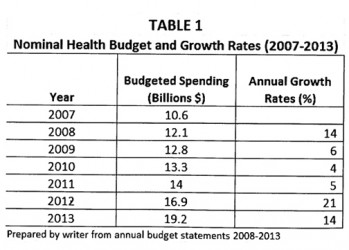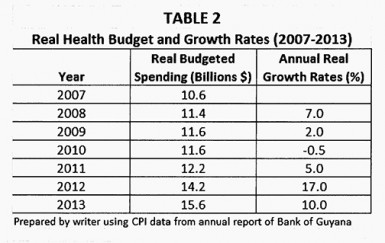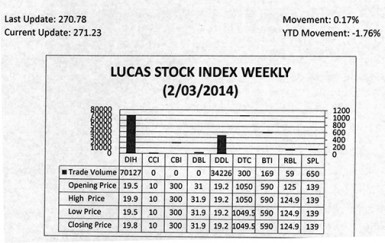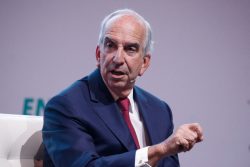There are 49 days left within which the 2014 budget must be presented to parliament. Given the shortness of the time span, it is fair to say that Guyana has entered the budget season. Generally, the budget season brings some measure of anticipation as people wonder what was in store for them. Over the next few weeks, this column will discuss past budget proposals to forecast the likely growth in spending by the administration on various parts of the social sector. It will focus on areas of the social sector that are not traditionally examined in evaluations of the budget.
High politics
The anticipation for 2014 has been heightened with the recent ruling of the Chief Justice that the opposition has got to keep its budget-cutting knives at home or in its pocket when it sees what the government has on its shopping list this year. With the ruling of the Chief Justice, many anticipate a constitutional crisis whenever the budget proposal reaches parliament in the next 49 days. There is the strong belief that the proposal for spending would be made deliberately unpalatable to the opposition that it would have no choice but to disapprove of the budget in whole or in parts. Such a course of action would leave the administration financially impotent. The resolution to such an outcome would be negotiations or fresh elections. Since the administration has shown no appetite for compromise in all its years in office, one could only envisage that its recourse would be to call early elections. To use a once popular idiom, Guyana was likely to see factors of high politics encounter factors of low politics.
The scenario above assumes that a prerequisite for early elections is the submission of a budget proposal with a high degree of dissatisfaction to the opposition. Should the administration go down that road, it means that it not only becomes a plan for future spending but also a signal to its supporters of what could be in store for them if re-elected with a clear parliamentary majority. In this context the budget does not serve as a financial plan but as a carrot for votes. Irrespective of the motive, it is still reasonable and responsible to reflect on the likely substance of the 2014 budget. This week’s column intends to take a look at one aspect of the budget. In this instance, the focus would be on health.
Policy focus
For the past six years, the administration has held a line to convey the impression that its economic programme was intended to create a country that served all Guyanese. The investment in this policy consisted of repeated references to several strategies that were supposed to transform the economy and improve the lives of Guyanese. Among them were managing the economy responsibly and avoiding short-term actions that could undermine the potential for long-term growth. A key policy line in this regard was the investments that were made in social services of education, health, housing, water, and sanitation. One cannot tell from the budget statements however if the policy to improve the lives of Guyanese includes consistently helping them to live healthier lives. Objectives of that nature are not made clear in the budgets despite the nice sounding intent to create a country that serves all Guyanese. Indeed, the people of this country should not expect any financial support for preventive health care.
Expansion
Previous budget proposals in the area of health provide evidence that there could be a nominal expansion of at least 10 per cent in the health budget this year since the administration has not been shy about increasing spending in this sector. Table 1 below shows the nominal increases in spending that were proposed for the health sector from 2007 to 2013. The smallest increase so far has been in 2010 when the budget grew by four per cent. The highest increase to date during the review period is 21 per cent which took place two years ago. An average 15 per cent of the investment that was planned was aimed at developing the healthcare infrastructure. Training of staff and medical supplies were other areas of emphasis in previous health budgets. This investment in the future of healthcare appears targeted at interventions to cure persons and not to treat them.
The growth in spending was not only in nominal terms. It was also true in real terms as could be seen from Table 2 below. The calculation of the proposed real expenditure used 2007 as the base year and it used the Consumer Price Index found in the annual report of the Bank of Guyana for the comparative years.
Real growth
As could be seen from the table, the health sector acquired increases in goods and services by an annual average of seven per cent during 2007 to 2013. The largest budgeted acquisition was again in 2012 when the administration planned to increase its acquisition of goods and services by 17 per cent. However, the proposed growth in purchases was not all positive. The administration was faced with a situation where the level of expenditure planned for the health sector was insufficient to meet its needs. Based on past experience, Guyanese could expect to see the health component of the budget grow in nominal terms for a seventh consecutive year and in real terms for a fourth consecutive year.
Statistical data provided by the Ministry of Health and published by the Bureau of Statistics indicated that in 2009, there were 1,620 hospital beds in Guyana. World Bank data indicate that Guyana has two hospital beds for every 1,000 persons. This ratio is better than 36 countries, including Belize, Dominican Republic, Jamaica, Malaysia and Venezuela. Guyana therefore was spending an estimated G$7.2 million per hospital bed. This translates also into $20,000 per day per bed. Assuming a one hundred per cent daily occupancy, it could be concluded that the expenditure represented the daily cost of keeping one patient in the hospital bed. But it is also known that the health institutions treat outpatients as well. This observation carries the implication that the daily expenditure per patient was much lower than $20,000. A more acceptable measure of healthcare spending on the people of Guyana would be the per capita figure. Annual per capita spending in 2009 was estimated at $15,000 which translates into $41 per day.
Prevention versus cure
To the extent that Guyanese could remain healthy, they could save the government $41 per day in healthcare costs. In thinking of the budget proposal for 2014, one would need to inquire as to how much of the planned investment in healthcare would be for prevention and how much would be for cure. While it is true that no one could predict with any certainty what the eventual health condition of a person would be, it is likely that people would change their behaviours if they had enough information about the risks that they faced.
Avoidance
Threats to the lives of Guyanese lurk in the increasingly filthy environment in Georgetown and other parts of Guyana. Avoiding disease from insanitary sources would be an important and useful way to start or enhance a prevention programme. Next week’s article is going to examine the budget proposals and the administration’s efforts towards sanitation.
LUCAS STOCK INDEX
The Lucas Stock Index (LSI) rose 0.17 per cent in trading during the first week of February 2014. The stocks of six companies were traded with a total of 105,531 shares changing hands. There was one Climber and two Tumblers. The shares of Banks DIH (DIH) rose 1.54 per cent while those of Demerara Tobacco Company (DTC) and Republic Bank Limited (RBL) fell 0.05 and 0.08 per cent respectively. The stocks of Demerara Distillers Limited (DDL), Guyana Bank for Trade and Industry (BTI) and Sterling Products Limited (SPL) remained unchanged.












